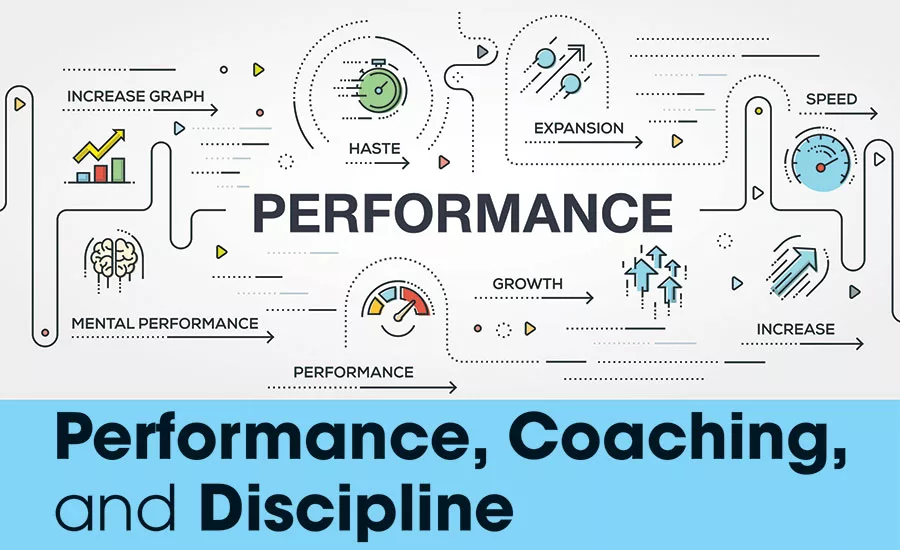Performance, Coaching, and Discipline

It’s not unusual for managers to get the order of things wrong when dealing with employee performance issues. In their haste to create a sense of urgency, many will go directly to a verbal or written warning when expectations are not being met. Continued failure to perform at the needed level then leads to increasingly more severe discipline such as time off without pay or a suspension. Those with some awareness of disciplinary measures may ultimately implement a Performance Improvement Plan (PIP) as a last resort before termination.
The above scenario is all too common, and the steps taken are not in the correct sequence. To help remedy this wrong, let’s go through the appropriate steps in establishing expectations for your employees, training them, coaching them when behaviors or performance are not acceptable, and moving to a disciplinary process as the final step when performance continues to fall short.
Establishing expectations
Setting clear expectations is the first and most important step in creating an environment for employees to succeed. Whether they are new to your company or new to their position, having a clear understanding of how their performance will be measured and the expectations for their performance against those goals or targets is critical. Some of the expectations are behavioral: showing up on time, meeting the company’s policy for proper attire and grooming, and use of appropriate language. Others are more performance oriented, such as completing work of acceptable or better quality in the allotted time. For instance, having an estimate written within 48 hours of the initial site visit or completing the planned number of calls per week on insurance agents who are prospects for referring work. Whatever position is involved, you should develop clear expectations for your employees and review them annually to be sure they continue to be accurate.
When you are certain that your employees understand what is expected, you’ve eliminated the often-heard reaction they have to the first conversation where you bring a lack of performance or the existence of unacceptable behavior to their attention: “I didn’t know ...!”
Especially for new employees, be sure to provide regular feedback, at least weekly, so they know how they’re doing. This feedback will likely be a combination of reinforcing some things they are doing particularly well and pointing out areas where they need to improve. In both cases, be objective and be specific. Give them examples of when they’ve done well and details on what changes are needed.
Training
If you have promoted or moved an existing employee into a new position, you are presumably aware of their strengths and weaknesses. Training needs should have been considered before the move was made, even if the plan includes continued development once they are in their new role. For new employees, their actual knowledge, experience, and capabilities are more of an unknown. While “experience in the industry” is often sought after, this means your new hire comes with habits and ways of performing work that may not fit with your operating model. Planning in advance to train them on your processes, procedures, and documentation, for example, will help avoid problems down the road. Again, constant, timely feedback is important early on.
Investing in training at this stage is money well spent. Remember, it is usually more difficult to re-train someone who has many years of experience doing a task a certain way than it is to train an employee new to the position on how to perform correctly from the start.

Coaching
If lower than acceptable performance continues, the next avenue to pursue is coaching. One of the most effective tools used to support coaching is the Performance Improvement Plan (PIP) which is designed to address specific problem areas by identifying three critical elements:
- The standards of performance and/or conduct that are under consideration.
- The employee’s performance problems as they relate to the standard.
- Steps to be taken to correct the performance problems.
The “improvement plan” section should specify the training and/or other actions that will be taken to address the performance problems and a reasonable, mutually agreed-upon timeframe in which to see the expected improvements.
In the one-on-one discussion held between the supervisor and employee, the supervisor should establish consequences for failure to meet and sustain improved performance. An important element in these conversations is to effectively communicate the significance and seriousness of the issue(s). Clear explanation of why the current level of performance is not acceptable is vital.
Feedback is, again, an important element. Periodic reviews — a minimum of one up to a maximum of six — should be conducted on a regular basis with the employee. At the end of the agreed PIP period, which will typically range from 30 to 90 days, the supervisor will determine if the improvement plan was successfully completed or if corrective action is required. If needed, additional training or development steps can be defined and implemented.
Discipline
The goal is for the process outlined in the PIP to correct the employee’s performance issues, while ongoing supervisor–employee conversations and feedback reinforce the changes, resulting in sustained performance improvement. If this is not the case, moving to an escalating discipline process is called for. At each step in the process the employee should be reminded of the seriousness of the issue(s). You must also ensure that they clearly understand the consequences of their failure to improve.
Our job as owners and managers is to give our people the greatest chance of being successful and growing as professionals and individuals. When they don’t succeed, we should view that as failure on our part. For an employee who is new to a job, setting the stage at the outset with clear expectations and appropriate training are minimum requirements for effective leadership. Using the proper process and executing the steps effectively in cases where performance is not meeting expectations should significantly improve the likelihood of success — for you and your employees.
Looking for a reprint of this article?
From high-res PDFs to custom plaques, order your copy today!







